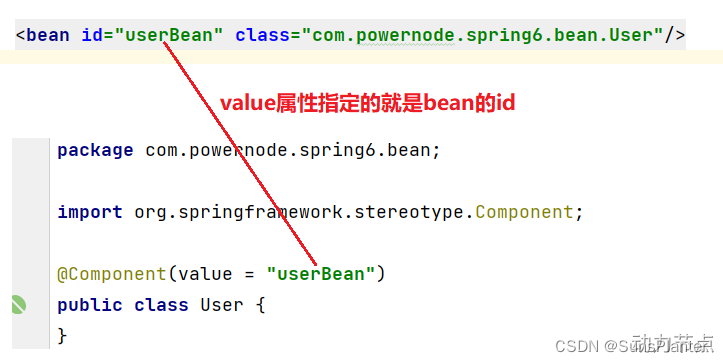11Spring IoC注解式开发(上)(元注解/声明Bean的注解/注解的使用/负责实例化Bean的注解)
注解的存在主要是为了简化XML的配置。Spring6倡导全注解开发。
注解开发的优点:提高开发效率
注解开发的缺点:在一定程度上违背了OCP原则,使用注解的开发的前提是需求比较固定,变动较小。
1 注解的注解称为元注解
自定义一个注解:
package com.sunsplanter.annotation;import java.lang.annotation.ElementType;
import java.lang.annotation.Retention;
import java.lang.annotation.RetentionPolicy;
import java.lang.annotation.Target;@Target(value = {ElementType.TYPE,ElementType.FIELD})
@Retention(value = RetentionPolicy.RUNTIME)
public @interface Component {String value();
}
- 该注解上面修饰的注解包括:Target注解和Retention注解,这两个注解被称为元注解。
- Target注解用来设置Component注解可以出现的位置,以上代表表示Component注解只能用在类和接口上。
- Retention注解用来设置Component注解的保持性策略.
SOURCE:注解只被保留在Java源文件中,class文件不包含注解.
CLASS:注解最终被保留到class文件中,但不能被反射机制读取.
RUNTIME:注解最终被保留到class文件中,并且可以被反射机制读取.
String value(); 是Component注解中的一个属性。该属性类型String,属性名是value。
2 管中窥豹注解的作用-通过反射机制读取注解
目标:只知道报包名:com.sunsplanter.bean,至于这个包下有多少个Bean我们不知道。哪些Bean上有注解,都不知道.
通过程序全自动化判断: 若Bean类上有Component注解时,则实例化Bean对象,如果没有,则不实例化对象。
我们准备两个Bean,一个上面有注解,一个上面没有注解。
package com.sunsplanter.bean;import com.sunsplanter.annotation.Component;@Component("userBean")
public class User {
}
package com.sunsplanter.bean;public class Vip {
}
package com.sunsplanter.test;import com.sunsplanter.annotation.Component;import java.io.File;
import java.net.URL;
import java.util.Arrays;
import java.util.Enumeration;
import java.util.HashMap;
import java.util.Map;public class Test {public static void main(String[] args) throws Exception {// 存放Bean的Map集合。key存储beanId。value存储Bean。Map<String,Object> beanMap = new HashMap<>();String packageName = "com.sunsplanter.bean";//将com.sunsplanter.bean转化成com/sunsplanter/bean并存到path中String path = packageName.replaceAll("\\.", "/");//获取这个包在系统中的绝对路径:file:/D:/study/spring6/spring6-005-Annotation/target/classes/com/sunsplanter/beanURL url = ClassLoader.getSystemClassLoader().getResource(path);//获取一个绝对路径下的所有子文件,并写入文件数组File file = new File(url.getPath());File[] files = file.listFiles();Arrays.stream(files).forEach(f -> {//获取两个类的相对包路径,如com.sunspalnter.bean.User...String className = packageName + "." + f.getName().split("\\.")[0];try {Class<?> clazz = Class.forName(className);if (clazz.isAnnotationPresent(Component.class)) {Component component = clazz.getAnnotation(Component.class);String beanId = component.value();Object bean = clazz.newInstance();beanMap.put(beanId, bean);}} catch (Exception e) {e.printStackTrace();}});System.out.println(beanMap);}
}
3 声明Bean的注解
通过注解声明该类是一个bean类,今后就会被自动创建bean对象.
负责声明Bean的注解,常见的包括四个:
- @Component
- @Controller
- @Service
- @Repository
通过源码可以看到,@Controller、@Service、@Repository这三个注解都是@Component注解的别名。
也就是说:这四个注解的功能都一样, 只是为了增强程序的可读性,建议:
● 控制器类上使用:Controller(主要用于给前端返回数据的以及接收前端的数据的)
● service类上使用:Service(处理数据用的)
● dao类上使用:Repository
他们都是只有一个value属性。value属性用来指定bean的id,也就是bean的名字。

4 Spring注解的使用
如果使用以上的注解, 就不必再每一个类都使用一个bean标签管理. 如何使用以上的注解呢?
● 第一步:加入aop的依赖
● 第二步:在配置文件中添加context命名空间
● 第三步:在配置文件中指定扫描的包
● 第四步:在Bean类上使用注解
第一步:加入aop的依赖
当加入spring-context依赖之后,会关联加入aop的依赖。所以这一步不用做。
第二步:在配置文件中添加context命名空间, 分别是xmlns:context和xsi:schemeLocation
<?xml version="1.0" encoding="UTF-8"?>
<beans xmlns="http://www.springframework.org/schema/beans"xmlns:xsi="http://www.w3.org/2001/XMLSchema-instance"xmlns:context="http://www.springframework.org/schema/context"xsi:schemaLocation="http://www.springframework.org/schema/beans http://www.springframework.org/schema/beans/spring-beans.xsdhttp://www.springframework.org/schema/context http://www.springframework.org/schema/context/spring-context.xsd">
</beans>
第三步:在配置文件中指定要扫描的包
<?xml version="1.0" encoding="UTF-8"?>
<beans xmlns="http://www.springframework.org/schema/beans"xmlns:xsi="http://www.w3.org/2001/XMLSchema-instance"xmlns:context="http://www.springframework.org/schema/context"xsi:schemaLocation="http://www.springframework.org/schema/beans http://www.springframework.org/schema/beans/spring-beans.xsdhttp://www.springframework.org/schema/context http://www.springframework.org/schema/context/spring-context.xsd"><context:component-scan base-package="com.sunsplanter.bean"/>
</beans>
第四步:在Bean类上使用注解
package com.sunsplanter.bean;import org.springframework.stereotype.Component;@Component(value = "userBean")
public class User {
}
第四步要小心, 存在两个两个Component

第二个时上面学习时自己建的,一定要选第一个.
第五步:编写测试程序
package com.sunsplanter.test;import com.sunsplanter.bean.User;
import org.junit.Test;
import org.springframework.context.ApplicationContext;
import org.springframework.context.support.ClassPathXmlApplicationContext;public class AnnotationTest {@Testpublic void testBean(){ApplicationContext applicationContext = new ClassPathXmlApplicationContext("spring.xml");User userBean = applicationContext.getBean("userBean", User.class);System.out.println(userBean);}
}
成功输出一个对象.
如果注解的属性名是value,那么value是可以省略的。
例如:
package com.sunsplanter.bean;import org.springframework.stereotype.Component;@Component("userBean")
public class User {
}
package com.sunsplanter.test;import com.sunsplanter.bean.User;
import org.junit.Test;
import org.springframework.context.ApplicationContext;
import org.springframework.context.support.ClassPathXmlApplicationContext;public class AnnotationTest {@Testpublic void testBean(){ApplicationContext applicationContext = new ClassPathXmlApplicationContext("spring.xml");User userBean = applicationContext.getBean("userBean", User.class);System.out.println(userBean);}
}
仍能输出一个User对象.
甚至: 如果把value属性彻底去掉,该类在被创建成bean时会被自动指定一个bean id(名字), 默认名字的规律是:Bean类名首字母小写即可。
多个包需要扫描的情况
办法1(常用): 指定需要扫描的多个包的共同父包,扫描这个共同父包. 缺点是如果父包有不需要扫描的包,则会牺牲一些效率.
办法2: 逗号分隔多个需要扫描的包:
<context:component-scan base-package="com.sunsplanter.bean,com.sunsplanter.dao"/>
5 根据注解类型选择性实例化Bean
假设在某个包下有很多Bean,有的Bean上标注了Component,有的标注了Controller,有的标注了Service,有的标注了Repository.
目标: 现在由于某种特殊业务的需要,只允许其中所有的Controller参与Bean管理,其他的都不实例化。
这里为了方便,将这几个类都定义到同一个java源文件中了:
package com.sunsplanter.spring6.bean3;import org.springframework.stereotype.Component;
import org.springframework.stereotype.Controller;
import org.springframework.stereotype.Repository;
import org.springframework.stereotype.Service;@Component
public class Selective_Instantiation_of_Objects{public Selective_Instantiation_of_Objects() {System.out.println("A的无参数构造方法执行");}
}@Controller
class B {public B() {System.out.println("B的无参数构造方法执行");}
}@Service
class C {public C() {System.out.println("C的无参数构造方法执行");}
}@Repository
class D {public D() {System.out.println("D的无参数构造方法执行");}
}@Controller
class E {public E() {System.out.println("E的无参数构造方法执行");}
}
<?xml version="1.0" encoding="UTF-8"?>
<beans xmlns="http://www.springframework.org/schema/beans"xmlns:xsi="http://www.w3.org/2001/XMLSchema-instance"xmlns:context="http://www.springframework.org/schema/context"xsi:schemaLocation="http://www.springframework.org/schema/beans http://www.springframework.org/schema/beans/spring-beans.xsdhttp://www.springframework.org/schema/context http://www.springframework.org/schema/context/spring-context.xsd">
<!--
use-default-filters="true" 表示:使用spring默认的规则,只要有Component、Controller、Service、Repository中的任意一个注解标注,则进行实例化。
use-default-filters="false" 表示:不再spring默认实例化规则,即使有Component、Controller、Service、Repository这些注解标注,也不再实例化。
<context:include-filter type="annotation" expression="org.springframework.stereotype.Controller"/> 表示只有Controller进行实例化。--><context:component-scan base-package="com.sunsplanter.bean" use-default-filters="false"><context:include-filter type="annotation" expression="org.springframework.stereotype.Controller"/></context:component-scan></beans>
测试程序:
@Test
public void testChoose(){ApplicationContext applicationContext = new ClassPathXmlApplicationContext("spring-choose.xml");
}
输出注解为@Controller的B,E构造方法执行.
目标: 现在由于某种特殊业务的需要,除了@Controller外的所有注解都参与Bean管理,仅Controller实例化。
<!--
use-default-filters="true" 表示:使用spring默认的规则,只要有Component、Controller、Service、Repository中的任意一个注解标注,则进行实例化。(不写默认是true)
use-default-filters="false" 表示:不再spring默认实例化规则,即使有Component、Controller、Service、Repository这些注解标注,也不再实例化。
<context:exclude-filter type="annotation" expression="org.springframework.stereotype.Controller"/> 表示将Controller排除出实例化的范围。--><context:component-scan base-package="com.sunsplanter.bean"><context:exclude-filter type="annotation" expression="org.springframework.stereotype.Controller"/></context:component-scan>
